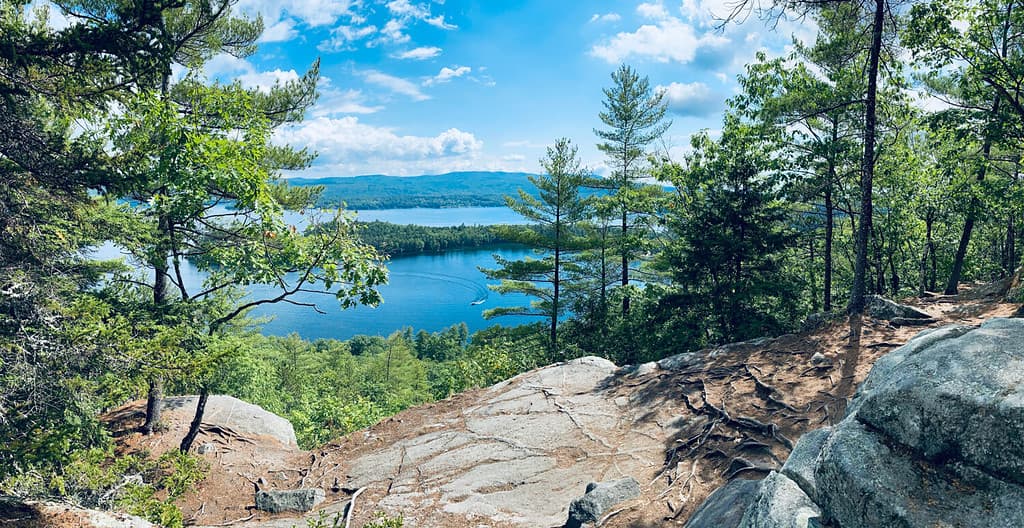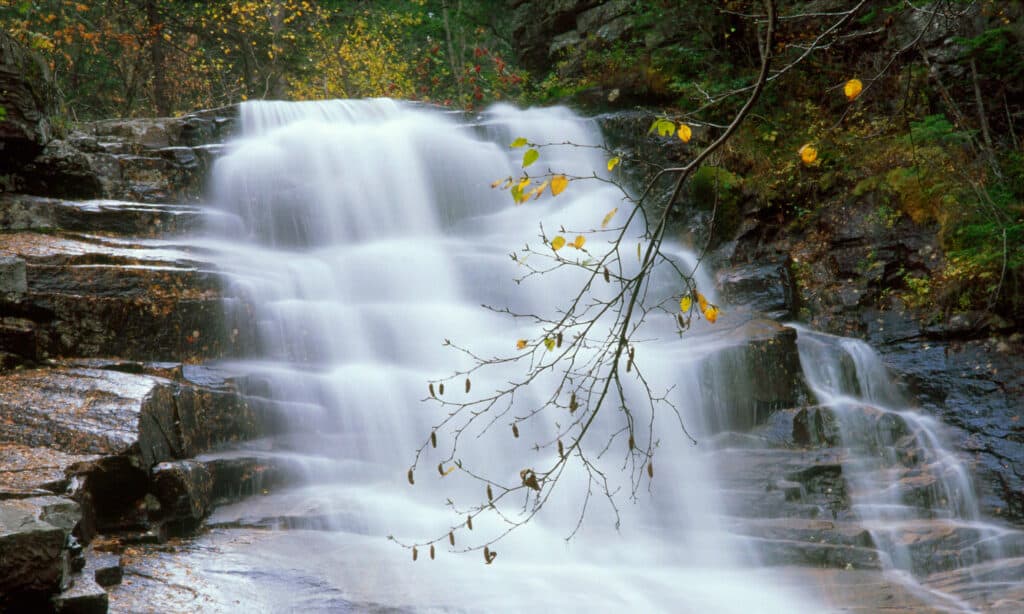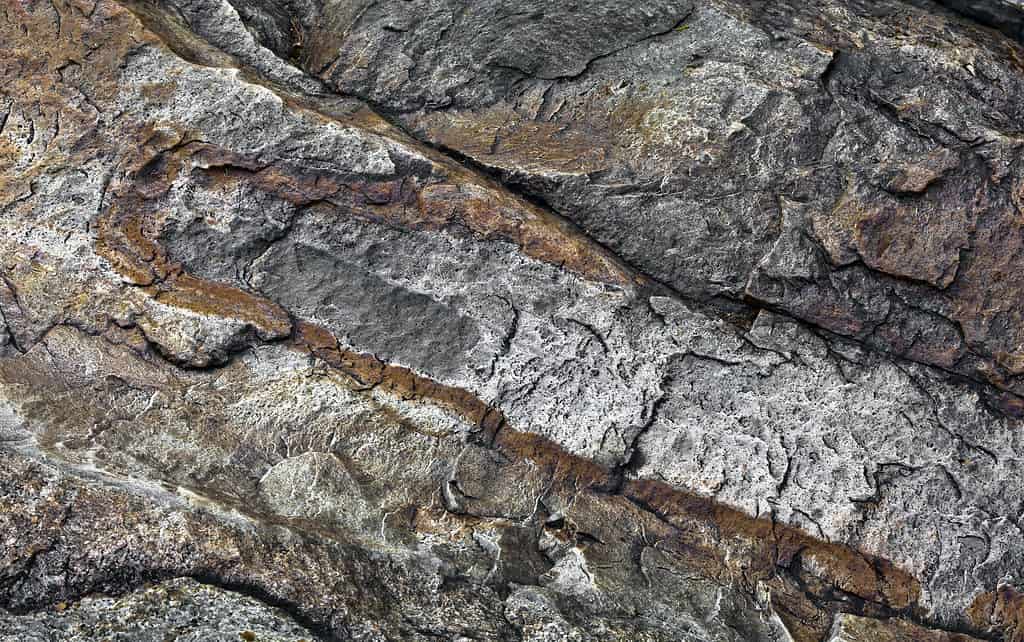Welcome to our blog post on why people call New Hampshire the Granite State. In this article, we will delve into the fascinating history and geological significance behind this nickname, shedding light on the abundance of granite in this beautiful northeastern state.
Why Is New Hampshire Called the Granite State?

The state of New Hampshire has large amounts of granite stone.
©Jon Michael Pics/Shutterstock.com
People have long been calling New Hampshire the “Granite State” due to its abundance of granite deposits. In 1825 a singer named Phil Carrigain wrote a song about New Hampshire and referred to it as the granite state. The nickname stuck and became popular. The state adopted this nickname officially in 1945, as it represents New Hampshire’s economic and industrial strength.
Throughout the 19th and 20th centuries, New Hampshire’s granite industry was a major source of revenue for the state. Granite quarries dotted the landscape, and New Hampshire became the leading producer of granite in the United States. Its granite was used by builders for a variety of purposes, from making monuments to creating curbs and sidewalks.
Granite was also used extensively by the construction industry to make the state’s infrastructure. Many of New Hampshire’s buildings, such as the statehouse and the Old Man of the Mountain monument, were carved from granite. Many of the state’s bridges, roads, and sidewalks are also constructed of granite.
Today, New Hampshire’s granite industry still remains a major source of income for the state. People still use its granite for a variety of purposes, from construction materials and monuments to sculptures and jewelry. With its abundance of granite resources, New Hampshire has earned its title as the Granite State.
What is Granite?

The Ripley Falls waterfall cascades down a granite wall in Crawford Notch, New Hampshire.
©Paul A Smith/Shutterstock.com
Granite is a type of igneous, or volcanic, rock formed from the cooling of magma deep underground. This cooling process produces a hard, durable rock composed of quartz, feldspar, and mica. You can find granite all over the world but is especially abundant in New Hampshire. Over 50 percent of New Hampshire has granite under the surface!
The White Mountains of New Hampshire are home to some of the most famous granite rock formations in the United States. The most iconic is the Old Man of the Mountain, a natural granite profile visible from miles away. Other popular granite formations in the area include the Flume, Franconia Notch, Cathedral Ledge, and Mount Washington.
Builders use granite for construction projects due to its durability and aesthetic appeal. They use it to make buildings, monuments, and sculptures around the world. Granite is also popular for countertops and flooring due to its long-lasting beauty.
How Do People Get Granite?

People get granite out of the earth with large machinery.
©N00dles/Shutterstock.com
People obtain granite by quarrying, the process of excavating stone from the ground. In the past, quarrying involved the use of manual labor and simple tools such as hammers and chisels. But today, modern technology allows for the use of larger and more efficient tools, including diamond-tipped saws, hydraulic splitters, and even explosives.
When quarrying for granite, workers first create an open-pit mine. They do this by removing the overburden (the layer of soil or rock above the stone) and then drilling and blasting the stone. Then they cut the granite into blocks with diamond-tipped saws and separated them into slabs with hydraulic splitters. They transport the slabs to a processing facility on big trucks. There, they polish and cut the granite into whatever shape they need for the project.
Quarrying is a difficult and dangerous job. But by using modern technology, the process has become much safer and more efficient. With the right tools and experienced workers, quarrying for granite is a responsible and sustainable practice.
The Granite Industry in New Hampshire

Close-up of granite rock, New Hampshire.
©John A. Anderson/Shutterstock.com
The terrain of New Hampshire is dotted with rocky outcroppings of granite, making it aptly named the Granite State. During the 19th century, the extraction of this stone became one of the state’s most profitable industries, with over 1,000 workers employed by dozens of quarries and 30 manufacturers based near the capital city. The process of quarrying the stone was laborious and hazardous, as workers had to manually drill into deep pits without any safety gear. The available tools limited the size and quality of the blocks, making it difficult to find the right stone for certain projects.
John Swenson, who was born in Sweden, arrived in New Hampshire and decided to learn the granite industry. He purchased George Ballard’s quarry operation on Rattlesnake Hill in 1883 for $750 and shortly after bought Hollis Quarry and Railway Quarry to provide better rock for both monumental and building purposes. Now, the Swenson Granite Company is the largest granite quarry operation in New Hampshire and owns 200 acres that run three miles in length.
Other State Symbols of New Hampshire
New Hampshire is a state with a lot of nicknames. People call it the White Mountain State because of the mountain range of the same name. Folks also call New Hampshire the Mother of Rivers because of the abundance of New England rivers that originate up in the mountains of the state. Some refer to New Hampshire as the Switzerland of America because of its gorgeous mountain landscapes. Here are a few other state symbols of New Hampshire.
New Hampshire State Motto
The state motto of New Hampshire is “Live Free or Die.” This phrase was first used by General John Stark in a toast he made to his officers in 1809. This motto inspires the citizens of New Hampshire to embrace the spirit of self-determination and independence. It also serves as a reminder to always stand up for what you believe in and not be afraid of the consequences. The phrase has become a part of the New Hampshire identity and serves as a powerful and lasting reminder of the determination and courage of the people of New Hampshire.
The State Bird of New Hampshire — The Purple Finch

©Fiona M. Donnelly/Shutterstock.com
The purple finch has been the New Hampshire state bird since 1957. This small songbird has striking red-and-purple-streaked plumage, a white belly, and a long tail. It is a beautiful sight to behold in the wild, with its vibrant colors and melodic chirping. Its diet consists mainly of small fruits and seeds, making it a common backyard visitor. The purple finch is a beloved symbol of New Hampshire and a reminder of its natural beauty.
The State Tree of New Hampshire—White Birch

New Hampshire adopted the white birch as their official state tree in 1947.
©Drovnin/Shutterstock.com
The white birch was officially adopted as New Hampshire’s state tree in 1947. It is a medium-sized, deciduous tree with a graceful, slender trunk and a rounded crown. Its bark is smooth and white or silver-white, often marked with black scars. The leaves are triangular, and their flowers are small and yellowish. The white birch is a symbol of resilience, standing tall through the cold New Hampshire winters. Its beauty and strength make it an iconic representation of the Granite State.
The State Bird of New Hampshire — Ladybug

The humble ladybug is a sign of good luck in New Hampshire, and residents are careful not to harm one.
©Ger Bosma Photos/Shutterstock.com
New Hampshire officially adopted the ladybug as its state insect in 1977. Ladybugs are small, round beetles with distinctive black spots and reddish-orange coloring. They feed on aphids and other plant-eating insects, making them beneficial to gardens and crops. Ladybugs are symbols of good luck and live in gardens and woodlands.
The State Flower of New Hampshire — Purple Lilac

Lilacs in bloom are a beautiful sight in New Hampshire.
©NikolayTsyu/Shutterstock.com
The purple lilac has been the state flower of New Hampshire since 1919. It is a deciduous shrub with fragrant clusters of flowers in shades of pink, purple, and white. The purple lilac is an enduring symbol of spring and looks beautiful in landscaping and gardening. It is also a long-lasting cut flower and a symbol of beauty, youth, and innocence.
The State Fruit of New Hampshire — Pumpkin

New Hampshire took on the pumpkin as their official state fruit in 2006.
©Studio Barcelona/Shutterstock.com
In 2006, New Hampshire officially adopted the pumpkin as its state fruit. This beloved gourd is great in pies and decorations and as a symbol of fall. Pumpkins are also an important part of the state’s agricultural heritage.
The State Amphibian of New Hampshire — The Red-Spotted Newt

The Red Spotted Eastern Newt (Red Eft) or
salamander
is the state amphibian of New Hampshire.
©iStock.com/epantha
New Hampshire’s state amphibian is the red-spotted newt, adopted in 1985. We proudly recognize this unique creature as part of our state wildlife. The red-spotted newt is a beloved symbol of our region and a reminder of our important connection to nature.
The State Animal of New Hampshire — White-Tailed Deer

New Hampshire has many deer and named the white-tailed deer the official state animal in 1983.
©Jim Cumming/Shutterstock.com
In 1983, New Hampshire adopted the white-tailed deer as its state animal. This majestic creature lives throughout the state, providing a beautiful and serene sight. Its spotted coat and large, bushy tail make it a unique and awe-inspiring animal.
The photo featured at the top of this post is © N00dles/Shutterstock.com
Thank you for reading! Have some feedback for us? Contact the AZ Animals editorial team.







